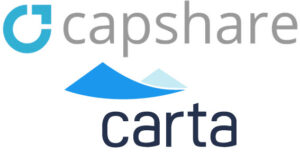 In the past few years, my private company clients have been flocking to online, cloud-based cap table services, such as Capshare and Carta (formerly eShares), as a platform to manage the company’s back-office functions for their capital structure. Aside from presenting an online cap table for reference by potential new investors and others, these sites provide a number of other services, such as being an online repository for documentation like stock option agreements and facilitating company valuations under Section 409A of the Internal Revenue Code.
In the past few years, my private company clients have been flocking to online, cloud-based cap table services, such as Capshare and Carta (formerly eShares), as a platform to manage the company’s back-office functions for their capital structure. Aside from presenting an online cap table for reference by potential new investors and others, these sites provide a number of other services, such as being an online repository for documentation like stock option agreements and facilitating company valuations under Section 409A of the Internal Revenue Code.
These services are sold as being time savers: they save the time of the companies from having to locate, for example, the right version of an option agreement and all the associated emailing. They also seek to prevent companies from having to pay expensive service-providers, such as yours truly, from having to spend hours on items that could be automated, like identifying calculation errors in a cap table. It wouldn’t seem in my self-interest to view this trend positively because it means less work for me at least in the short term. But I am in favor of any trend that means less time-consuming drudgery for my firm. It means more of our time is spent on truly valuable legal services, and less time on boring work that creates legal bills that annoy clients.
To me, the most important advantage of online cap tables is that they enforce a discipline on companies by imposing a standardized method of data entry and presentation that heads off all the confusion that results from each company having its own unique spreadsheet format for cap tables. It is already complicated enough trying to understand the capital structure of private companies that have, for example, multiple versions of convertible notes or SAFEs with varying terms along with multiple series of preferred stock. When all of that is presented on an Excel spreadsheet with incorrect formulas and quirky formatting, it’s a recipe for expensive, time-consuming back-and-forth. In essence, online cap tables help ensure that everyone is speaking the same language and has the same understanding of a company’s ownership.